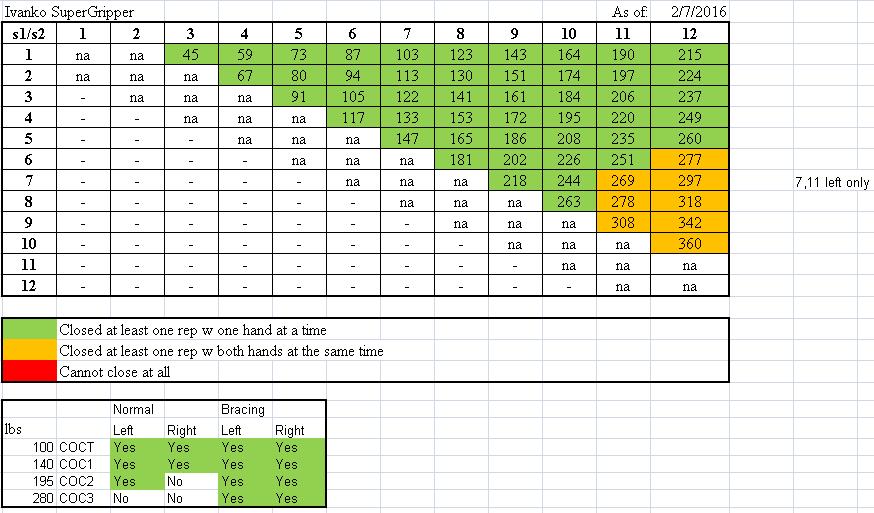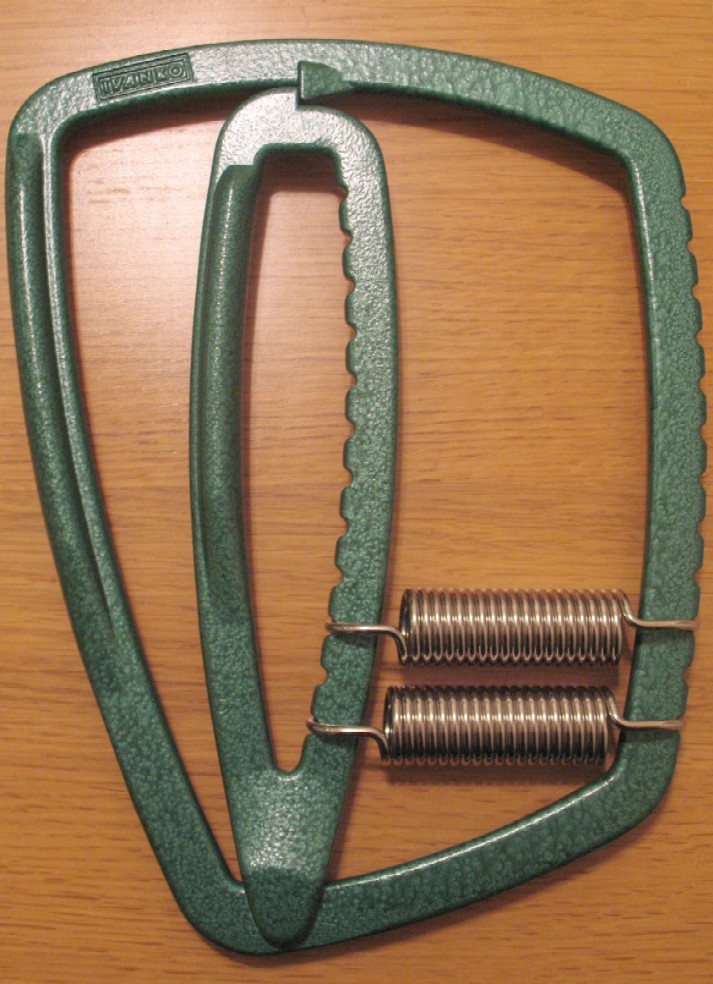The Importance of Gripping
12/27/07
While there is no best martial art, there is one type of martial skill that best satisfies my requirements for rational and effective real life self defense that can be taught in any martial art, and that is to concentrate on gripping.
In no particular order, a few reasons I came up with, are
- If you mess up a grip, your technique may still work. If a grip is done too soon it can be a punch; too late it can be a palm strike or slap. One of the requirements of a punch is to first 'make a fist' which is a grip.
- Gripping doesn't use too many 'body resources'. Your whole body is not required to be committed in order to do a grip. You can grip irrespective of first obtaining a good position (of course obtaining a good position first is obviously desired).
- Gripping is generally not telegraphed. You generally don't see grips coming unlike punches, kicks, some throws and chokes.
- No lengthy 'resetting' is involved. After you do a grip, you can do another one very quickly. You don't have to re-adjust your entire body.
- Gripping is used in standup, going to the ground, and on the ground. There are standing grips and gouges, throws, pinning to the ground, gi chokes, eye gouges, and throat and testicle crushes.
- Can use gripping with weapons. To use a weapon, basically any weapon I know of, gripping and controlling is mandatory.
- You can objectively measure gripping strength. Gripping force can be measured by settings on the Ivanko SuperGripper, for example, or a variety of other strength training devices.
- I'm guessing there are less strength assymetry issues in gripping. One hand will probably be stronger than the other, but much less so I imagine when compared to punching, for example.
- I'm guessing there tends to be more grip strength equality among males and females. There is still disparity, but much smaller than when comparing punching and kicking I imagine.
- Gripping is more functional, more fundamental than squatting and deadlifting, combined. It is useful for daily tasks, including other training methods. Gripping is useful for the thousands of gripping motions we use a day. You can truly practice it all day and anywhere. This is probably the most important aspect of training gripping in my opinion. The 99.99% of the time we are not fighting in real life self defense situations, you can actually use the training elsewhere in the exact same action but not in a martial context. Good luck convincing someone that the same can be said about punches and kicks and ground-n-pound. That is, because it is made a part of life it is useful and efficient to learn.
- Gripping is innate in us since birth. Babies grip. They don't punch, kick, throw, choke, etc. Well OK, you can feel them kicking in the womb, but that is not the same!
- Some animals use gripping. Think eagle talons, lobster and crab claws, and many more, for example.
- People of any age can train their grip. It is accessible to old and young.
- Other people generally don't train gripping and related techniques. I find that most do not, mainly because they think they are "dirty", "unsportsmanlike", "low blow", "against the rules", etc. This is dangerous thinking which is drilled into us at an early age and at every age, mainly because we are sport/entertainment-based thinkers, and obviously such fouls are bad for sport/entertainment, which is a friendly encounter. But why adhere to sport/entertainment thinking that could prove dangerous for you in real life self defense situations? Other people don't train it because since gripping is innate in us they think it is therefore trivial, or think that they will just pick it up along the way. Either way, people unfamiliar with it, either in sport/entertainment or real life, will be a bonus to you.
- Climbing. Self explanatory.
- Sherlock Holmes could tell a great deal about a person by looking at his or her hands
- Uneven pressure can be sensed, uniform pressure typically cannot be
- You can control your grip. A grip is generally a relatively small (when compared to kicks and punches) controllable force. These types of forces are more useful than large partially controllable forces.
- Specificity. The movement you're going to be doing outside the gym is the same you are doing inside the gym.
- Matches ancient martial art wisdom. Namely, to use a minimum amount of force.
- Gripping is not dependent on any environment. What other effective technique can you always do on land, irrespective of stance, can do in water, theoretically floating in space, etc. Grippers have the freedom of not being bounded by their surroundings.
- Gripping is a gross motor skill. One can grip with the adreneline flowing.
- It is hard to defend against all 'grippable' targets at once. It is hard to defend against grabs to vital areas such as the throat, testicles, and eyes at the same time.
- You can grip gi/nogi. Clothes or body parts can be grabbed.
- Sensitivity. Your martial skills become concentrated in an area of your body that is sensitive and can be trained to be more sensitive. This sensitivity equates to control.
- The pump. Because the muscles in the hand are so small, a bodybuilding "pump" in these structures is intensified.
- Good exercise for keyboard warriors. Those of us who are keyboard warriors need to exercise our hands more productively. We don't need to type with more force, but gripping can also add to our typing skills via endurance.
- You can practice gripping conveniently, minimum cost. Anywhere. No real cost.
- Grip training won't beat you up. Gripping is not damaging to you like getting knocked or choked out all the time. Although, you may want to read up on possible blood pressure issues. Make sure to also stretch the fingers and hand, do exercises in the opposite range of motion too. Create practice targets that are grippable.
- The gripper will not fall on you, crush your feet, etc. It drastically reduces the probability of injury due to equipment.
- The hands are often the first body part to come in contact with someone else. Therefore we need to know how to use them! This applies to martial situations, but also just being introduced to someone, say at work.
- Grippers are extremely portable. Each gripper weighs ~ 2 lbs.
- Can be freely shared between training partners, even of different strength levels.
- Additional springs can be purchased, rubber bands can be used.
- Can use a gripper in each hand.
- Each hand can grip with a different amount of force at the same time.
- Techniques can be applied at different speeds.
- You can come away with DNA evidence from your attacker under your fingernails.
- Gripping is a low skill movement. It is about as pure of a pure strength movement there is.
- The thumb is one of the things that is involved in the grip, and the use of it is one thing that separates us from other life forms.
- Can grip hair to control, and also to expose neck to strikes.
- Gripping provides several directions of force/distortion. Grip a sphere of clay, and see how the clay gets distorted. It does in several directions, as opposed to mainly one direction in many strikes.
- The hand is one of the smallest (in mass) chunks of the body. How cool is it to have one of the smallest parts of your body be so effective?
- Two-handed gripping is very powerful. What one hand cannot grip, two often can.
- Strong grip equates to strong forearm, equates to strong arm, equates to strong chest, equates to being able to pick up large weights, equates to strong legs. Self explanatory.
I've found the Ivanko SuperGripper to be very useful for my goals. Most of the time, I'll do several dozen of what I've called a "Smith rep", which is one cycle of trying to close the gripper first with the left hand (or whichever hand is weaker), then the right hand, then both hands but leading with the left hand, then both hands but leading with the right hand. One could denote such a rep by the notation (L)(R)(BL)(BR). The reasoning behind it is that one's goal should ultimately be to be able to close a setting with one hand, which is more difficult than closing a setting with both hands, as well as both hands. Also, while switching from a single hand attempt to a both hands attempt, the hand leading in the both hands attempt should not be the same hand used for the single hand attempt, that is, the hand should be given a slight rest.
Check out my progress with the Ivanko SuperGripper and the Captains of Crush (COC) grippers to date:

Please anonymously VOTE on the content you have just read:
Like:Dislike:
